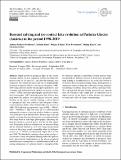Files in this item
Buoyant calving and ice-contact lake evolution at Pasterze Glacier (Austria) in the period 1998-2019
Item metadata
| dc.contributor.author | Kellerer-Pirklbauer, A. | |
| dc.contributor.author | Avian, M. | |
| dc.contributor.author | Benn, D. I. | |
| dc.contributor.author | Bernsteiner, F. | |
| dc.contributor.author | Krisch, P. | |
| dc.contributor.author | Ziesler, C. | |
| dc.date.accessioned | 2021-03-17T17:30:02Z | |
| dc.date.available | 2021-03-17T17:30:02Z | |
| dc.date.issued | 2021-03-10 | |
| dc.identifier | 273342920 | |
| dc.identifier | 2b2b8001-a722-4d76-8e82-205c202bfaf9 | |
| dc.identifier | 85102383409 | |
| dc.identifier | 000627628600001 | |
| dc.identifier.citation | Kellerer-Pirklbauer , A , Avian , M , Benn , D I , Bernsteiner , F , Krisch , P & Ziesler , C 2021 , ' Buoyant calving and ice-contact lake evolution at Pasterze Glacier (Austria) in the period 1998-2019 ' , The Cryosphere , vol. 15 , no. 3 , pp. 1237-1258 . https://doi.org/10.5194/tc-15-1237-2021 | en |
| dc.identifier.issn | 1994-0416 | |
| dc.identifier.other | Bibtex: tc-15-1237-2021 | |
| dc.identifier.other | ORCID: /0000-0002-3604-0886/work/90951758 | |
| dc.identifier.uri | https://hdl.handle.net/10023/21649 | |
| dc.description | This research has been supported by the Austrian Science Fund (grant no. FWF P18304-N10), the Hohe Tauern National Park authority (several projects), the Glockner-Öko-Fonds (GROHAG 2018), and the Austrian Alpine Association (through the annual glacier monitoring programme). | en |
| dc.description.abstract | Rapid growth of proglacial lakes in the current warming climate can pose significant outburst flood hazards, increase rates of ice mass loss, and alter the dynamic state of glaciers. We studied the nature and rate of proglacial lake evolution at Pasterze Glacier (Austria) in the period 1998–2019 using different remote-sensing (photogrammetry, laser scanning) and fieldwork-based (global navigation satellite system – GNSS, time-lapse photography, geoelectrical resistivity tomography – ERT, and bathymetry) data. Glacier thinning below the spillway level and glacier recession caused flooding of the glacier, initially forming a glacier-lateral to supraglacial lake with subaerial and subaquatic debris-covered dead-ice bodies. The observed lake size increase in 1998–2019 followed an exponential curve (1998 – 1900 m2, 2019 – 304 000 m2). ERT data from 2015 to 2019 revealed widespread existence of massive dead-ice bodies exceeding 25 m in thickness near the lake shore. Several large-scale and rapidly occurring buoyant calving events were detected in the 48 m deep basin by time-lapse photography, indicating that buoyant calving is a crucial process for the fast lake expansion. Estimations of the ice volume losses by buoyant calving and by subaerial ablation at a 0.35 km2 large lake-proximal section of the glacier reveal comparable values for both processes (ca. 1×106 m3) for the period August 2018 to August 2019. We identified a sequence of processes: glacier recession into a basin and glacier thinning below the spillway level; glacio-fluvial sedimentation in the glacial–proglacial transition zone covering dead ice; initial formation and accelerating enlargement of a glacier-lateral to supraglacial lake by ablation of glacier ice and debris-covered dead ice forming thermokarst features; increase in hydrostatic disequilibrium leading to destabilization of ice at the lake bottom or at the near-shore causing fracturing, tilting, disintegration, or emergence of new icebergs due to buoyant calving; and gradual melting of icebergs along with iceberg capsizing events. We conclude that buoyant calving, previously not reported from the European Alps, might play an important role at alpine glaciers in the future as many glaciers are expected to recede into valley or cirque overdeepenings. | |
| dc.format.extent | 22 | |
| dc.format.extent | 28292366 | |
| dc.language.iso | eng | |
| dc.relation.ispartof | The Cryosphere | en |
| dc.subject | GE Environmental Sciences | en |
| dc.subject | DAS | en |
| dc.subject | SDG 13 - Climate Action | en |
| dc.subject.lcc | GE | en |
| dc.title | Buoyant calving and ice-contact lake evolution at Pasterze Glacier (Austria) in the period 1998-2019 | en |
| dc.type | Journal article | en |
| dc.contributor.institution | University of St Andrews. School of Geography & Sustainable Development | en |
| dc.contributor.institution | University of St Andrews. Bell-Edwards Geographic Data Institute | en |
| dc.contributor.institution | University of St Andrews. Environmental Change Research Group | en |
| dc.identifier.doi | 10.5194/tc-15-1237-2021 | |
| dc.description.status | Peer reviewed | en |
This item appears in the following Collection(s)
Items in the St Andrews Research Repository are protected by copyright, with all rights reserved, unless otherwise indicated.

